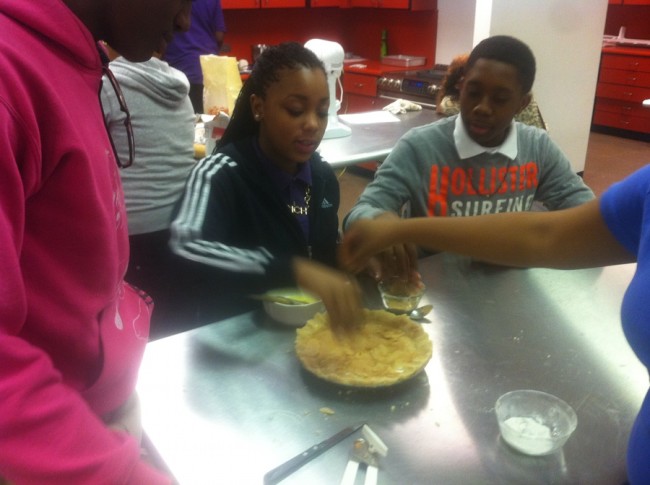
Growing up during the tail end of the Jim Crow era, Alpha Thomas remembers being able to purchase fresh fruits and vegetables from a string of neighborhood grocers right across from where she lived. Today, her beloved mom-and-pops are gone and the closest grocery store is more than a mile away.
Thomas is a longtime resident of South Dallas – a place the federal government calls a “food desert.”
“My main concern is the children in my neighborhood,” Thomas, now 56, said. “You go to the corner store and you see children buying Cheetos and sodas – food with empty nutritional value and high in calories. If the children are not receiving proper nutrition, then this is going to affect their thinking and their ability to be alert and function well.”
According to the United States Department of Agriculture, food deserts are impoverished neighborhoods without easy access to fresh fruit, vegetables and other healthful whole foods due to a lack of grocery stores or farmers’ markets in the area. The food available to the residents of these communities is mostly from fast food restaurants and corner stores that mainly sell heavily processed products rich in fat and sugar.
South Dallas is an area bordered by Interstate 30, White Rock Creek and the Trinity River. South Dallas encompasses about 15 neighborhoods, including Fair Park, and has a population of approximately 28,000 people.
Ken Smith, another longtime South Dallas resident and the president of a non-profit organization called the Revitalize South Dallas Coalition, said the ‘80s marked the change in his community’s sustainability. People started leaving because of new civil rights opportunities, reducing South Dallas’ population of 60,000 to its current count.
Smith says this population decline is the reason why there isn’t a Wal-Mart or Kroger in sight.
“If you are a grocer, you are going to want to build a store in places where people are moving to not in a place where people are moving away,” Smith said. “Most of the little stores here sell cigarettes and paraphernalia. They wouldn’t even know what fresh food looks like.”
Several organizations in Dallas, including Smith’s Revitalize South Dallas Coalition, have started initiatives that aim to alleviate the problem. Another initiative stemmed from a partnership between a non-profit organization called Get Healthy Dallas (GHD) and a capstone class at Southern Methodist University.
GHD co-founders Stacy Cherones and Robert Foster asked SMU Communication Studies professor Owen Lynch to help them with their research. The group connected with Lincoln High School, a school right smack in the middle of the South Dallas food desert and created a program called “Ignite Academy.” Cherones, Foster and Lynch developed a curriculum based on culinary arts, nutrition and entrepreneurship.
“Nobody wants to be poor and nobody wants to be stranded and nobody wants to be hungry,” Lynch said. “We wanted to create a culinary program where students can learn about food, proper preparation and be familiar with the food process. We also wanted to provide a place where students can learn about jobs and entrepreneurship.”
Aside from two grocery stores along Martin Luther King Blvd., Smith says South Dallas is only home to a couple of gas stations, a McDonald’s and Jack In The Box. He believes Ignite Academy, specifically its entrepreneurial aspect, is one of the keys to repopulating South Dallas and attracting chain grocers and businesses into the area.
“My hope is that it will integrate new businesses in that it would train students to be business-minded and to be business majors in college,” Smith said. “That way, they would return to the community to put their business skills to use in the area where they grew up. We cannot grow or develop or sustain a community by simply being employees of other people’s businesses – we have to start our own.”
According to Lynch, a community’s nutritional state is correlated to the state of its economy. Fifty percent of the female-run households in the South Dallas area are living in poverty. The area’s overall poverty rate is 27.5 percent and the per capita income is $12,500 in contrast to the whole Dallas area’s $43,000 average, making South Dallas both a food desert and a job desert.
“The economics of poor people is changing,” Thomas said. “When we have education, we can have money and as a result of having money then we can have access to fruits and vegetables. If our kids become educated with this knowledge and they pass that on to the community, then we can start making better decisions.”
Another program called “Warehouses to Greenhouses” addresses the food desert issue by converting abandoned warehouses into farms that grow food using a method called aquatonics. The Revitalize South Dallas Coalition managed to secure zoning that would allow GHD to develop an aquatonic greenhouse called “Fish Face Farms.”
“Aquatonics is a method of growing food without soil – the water feeds the plants,” Lynch said. “We’re going to have fish and shrimp that clean the water and fertilize the plants. Fish Face Farms is going to be full profit venture and the money would go back to funding other programs for students at Lincoln High School.”
As these programs continue to develop, South Dallas residents like Thomas continue to hang on to the hope that it would empower her neighborhood’s youth and in turn improve the state of their community.
“South Dallas is my life,” Thomas said. “I understand what has happened to my community, but I have chosen to focus on its goodness and what I can do to make it better. When people are educated, they have knowledge that equips them to make better choices and better decisions. Having this program at our school will allow our youth to share that information with the community and that knowledge would spread like wild fire.”
Patricia Villacin is a senior at Southern Methodist University studying journalism and education. She can be reached at [email protected]










